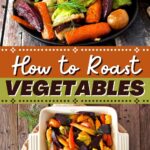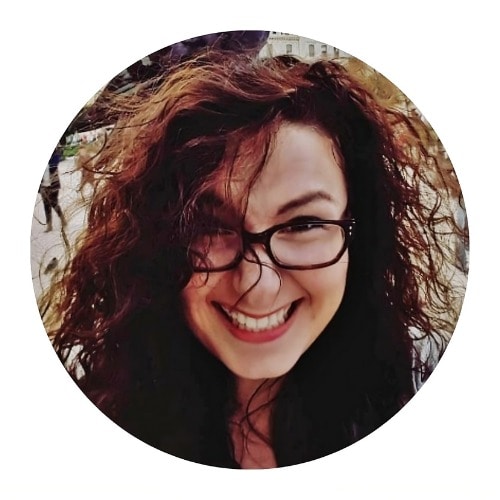One of the most important culinary skills you can learn is how to roast vegetables. Because roasted vegetables are game changers.
They’re easy to make and absolutely delicious!

Even picky, vegetable-hating humans will love roasted veggies.
I know from experience because I have a few in my family. But I can get them to eat roasted veggies.
Every time.
The best part is that roasting vegetables is customizable! You can pick your favorite veggies and stick with them. Or branch out and try something new each time.
No matter what, roasted vegetables are mouth-watering and healthy! #cantbeatthat
How to Roast Vegetables
The reason roasted vegetables are so darn good is caramelization.
All veggies contain natural sugars, and roasting them brings those sugars out. It also deepens the flavor of the vegetable.
This is achieved by dry-heat-cooking them in the oven at a high temperature.
Here’s how to roast vegetables, step by step.
1: Prepare and preheat.
- Preheat your oven to somewhere between 400- 425 degrees Fahrenheit.
- Lay a sheet of parchment paper over a shallow-sided baking/cookie tray and set aside.
- Chop all of your veggies and add them to a large bowl.
2: Add fat and seasoning.
- Drizzle your chopped veggies with your choice of fat.
- Olive oil, avocado oil, coconut oil, and melted butter are all fantastic options.
- Season the vegetables with the seasoning of your choice.
- I have a few fantastic options listed below.
- But you can always use a premade seasoning blend if that’s what you love.
- And always season with your heart (to taste)!
- Toss to coat all of the vegetables evenly.
- Transfer the seasoned veggies to the prepared baking tray. Spread them over the tray without crowding them.
You can use multiple trays if you’re making a lot of veggies.
Step 3: Get roasting!
- Bake the vegetables uncovered for 35-45 minutes, stirring them once halfway through.
- They’re ready when they’re fork-tender with caramelized edges.
Let them go a little longer for crispier results. Personally, I like to let them get a little charred. It adds a ton of flavor.

Best Vegetables for Roasting
In my professional opinion, ALL veggies are the best vegetables for roasting. I say choose the ones you like the most.
However, some people that would disagree.
They’re wrong.
But in all fairness, some veggies do roast a little better than others. Here are some of my favorites. This is not an exhaustive list.
- Root Vegetables– Potatoes, sweet potatoes, carrots, shallots, parsnips, beets, and cassava.
- Cruciferous Vegetables– Brussels sprouts, onions, garlic, broccoli, cauliflower, rutabaga, cabbage, and kale.
- Squashes– Zucchini, butternut squash, acorn squash, pumpkin, and delicata.
- Miscellaneous Vegetables– Asparagus, bell peppers, tomatoes, green beans, corn, and eggplants.
Roasted Vegetable Seasoning Ideas
- SALT– you gotta use salt, no matter the seasoning blend.
- The Basic Mix– salt, black pepper, paprika, garlic powder, and onion powder. I’d use this on pretty much all of them.
- Spicy– Add red pepper flakes or cayenne pepper for some heat.
- Honey + Something– Mix honey with mustard or hot sauce for a super yummy dressing. Drizzle it over your veggies towards the end of roasting.
- Herbs– You can use fresh or dried. But dried herbs may be the better option here. Rosemary, thyme, oregano, dill, chives, and parsley are fantastic choices.
- Cheesy– Top the veggies with your favorite cheese! I love parmesan and mozzarella. Cheese sauce works, too.
- Sugar, Spice, and Everything Nice– Use a combo of cinnamon, brown sugar, and pumpkin pie spice for a sweet treat. This works for pumpkin and sweet potatoes.
- Miscellaneous: Curry, balsamic, pesto, and citrus are fabulous options, too.
Honestly, use anything that sounds good to you.
Vegetable Roasting Times
These are just general, approximate roasting times.
All times depend on a few factors. These include your oven, altitude, size of the veggie pieces, and desired crispiness.
Root Vegetables (Potatoes, carrots, beets, etc.): 35- 40 minutes
Cruciferous Vegetables (Brussels sprouts, cauliflower, broccoli, etc.): 15- 25 minutes
Hard Squashes (Butternut, delicata, acorn, etc.): 30-60 minutes
Soft Squashes (Zucchini, summer squash, etc.): 15- 20 minutes
Soft and Thin Vegetables (Peppers, asparagus, green beans, etc.): 10- 20 minutes
Onions: 30- 45 minutes
Tomatoes: 15-30 minutes
Eggplants: 30- 40 minutes

Tips for Roasting Vegetables
- Save time by chopping all your veggies ahead of time. Or you can use pre-cut veggies!
- Also, don’t bother with peeling. The skins get really yummy as they roast.
- Make sure similar-density veggies are similar in size. This helps them roast evenly.
- For example, you want to roast potatoes, carrots, and zucchini together. Cut the carrots and potatoes into small, uniform pieces.
- But cut the zucchini into slightly larger pieces. Zucchini is softer and will cook more quickly.
- For example, you want to roast potatoes, carrots, and zucchini together. Cut the carrots and potatoes into small, uniform pieces.
- Make more veggies than you think you need. They have a pesky habit of disappearing fast.
- If you’re making a ton of veggies, group them by cooking time for the best results. Root veggies take the longest. And softer ones like peppers roast pretty quickly.
- If you use multiple pans, make sure to switch racks halfway through.
- I also recommend rotating your pan 180 degrees halfway through. This allows both sides to heat. But this isn’t 100% necessary.
- You rarely need to cover your veggies with foil when roasting them. You want them to stay drier and you want them to turn brown.
- Garlic is really the only exception to the above statement. You can do it in a few ways.
- Take an entire garlic bulb and chop off the tapered bit at the top. Drizzle it with olive oil and salt. Then wrap it in foil and roast until it’s soft.
- Or you can make garlic confit. Gather as many garlic cloves as you like and put them in a shallow baking dish. Fill it with olive oil and herbs.
- Roast it until the cloves are soft and jammy. This also makes delicious garlic oil!
- Don’t overcrowd your tray. This can cause soggy veggies.
- Using too much oil can also result in soggy veggies. They should all be coated with your fat but not dripping.
- Roasted veggies are best eaten immediately!

How to Serve Roasted Vegetables
Roasted vegetables literally go with everything.
You can use roasted veggies in soups, on salads, and alongside meat entrees. They’re great on hummus and pizza. And they taste fantastic in sandwiches!
Personally, I’m always down for sauteed chicken with a side of roasted veg.
Storing and Reheating Roasted Vegetables
Store any leftovers in an airtight container in the fridge for up 4 days. But they will lose their crispness after one night in the fridge.
You can freeze roasted veggies for up to 1 month in an airtight container. A freezer bag works well, too.
The best way to reheat roasted vegetables is in the oven.
- Drizzle them with a little more oil and put them in a preheated 450-degree Fahrenheit oven.
- Cook until they’re warmed through.
You can also reheat them in a skillet on the stove or the microwave. They just won’t be quite as crispy. But they’ll still taste fabulous.











